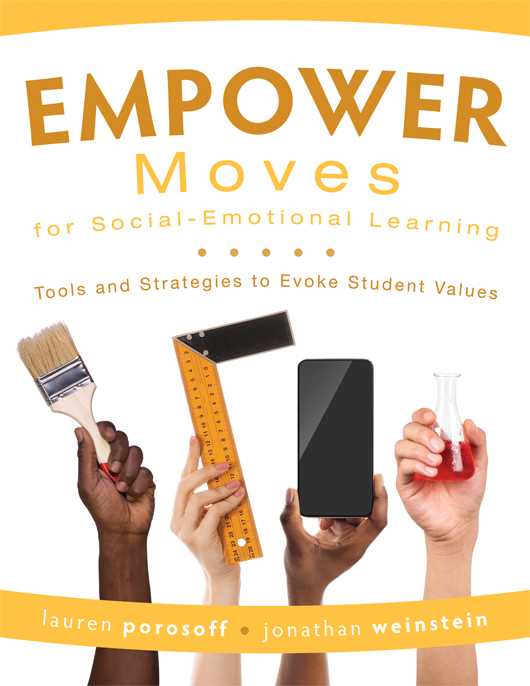Free Reproducibles
EMPOWER Moves for Social-Emotional Learning
Tools and Strategies to Evoke Student Values
EMPOWER students to make school a source of meaning, vitality, and community in their lives. Using this book’s interconnected processes—exploration, motivation, participation, openness, willingness, empathy, and resilience—students clarify and commit to the values they want to live by. You will learn 28 activities, as well as extensions and variations for each, that increase student engagement not only in school but in building meaningful lives.
Benefits
- Discover a process-based, non-prescriptive, personally relevant, and culturally affirming approach to SEL.
- Implement SEL as its own curriculum, a pedagogy for academic units of study, or a one-to-one intervention.
- Facilitate 28 adaptable SEL activities that invite students to identify their own values, choose how they live, and overcome internal struggles.
- Evoke students’ personal values without instilling particular values.
- Enhance intrinsic motivation, psychological flexibility, student and teacher self-reflection, and student voice.
- Build relationships, community, a sense of belonging, and compassion in the classroom.
- Have productive conversations with students and their families about living meaningful lives.
TABLE OF CONTENTS
Introduction: Social-Emotional Learning That Empowers Students
Part I: Social-Emotional Learning Activities That EMPOWER Students
Chapter 1: Exploration: Empower Students to Discover How Values Show Up in Their Lives
Chapter 2: Motivation: Empower Students to Associate Their Actions With Their Values
Chapter 3: Participation: Empower Students to Create Their Own Ways to Enact Their Values
Chapter 4: Openness: Empower Students to Share How Other People Move Them Toward Their Values
Chapter 5: Willingness: Empower Students to Serve Their Values When It’s Especially Hard
Chapter 6: Empathy: Empower Students to Understand and Care About One Another’s Values
Chapter 7: Resilience: Empower Students to Turn Their Struggles Into Opportunities to Reaffirm Their Values
Part II: Strategies That Make EMPOWER More Effective
Chapter 8: Designing an Empowering Social-Emotional Learning Program
Chapter 9: Supporting Students Who Struggle to Enact Their Values
Chapter 10: Inviting Families Into Conversations About Student Values
Epilogue: Making the Process the Outcome
Appendix
STUDY GUIDE
PRINTABLE REPRODUCIBLES
Chapter 1
- Figure 1.2 Values and Questions Card Game Setup
- Figure 1.3: Values and Questions Card Game During the First Round
- Domains of Life
Chapter 2
- Figure 2.1: Fun and Important Graph
- Things I Need to Do This Week
- Four Self Responses
- Enacting My Values When I Use Devices
Chapter 3
- Figure 3.1: About Emotions
- Figure 3.3: Emotions Reveal What Matters To Us
- Noticing My Emotions
- Choice Reflection
- Class Assessment
Chapter 4
Chapter 5
Chapter 6
- Figure 6.1: Values and Strengths Self-Assessment
- Common Values and Complementary Strengths Questions
- Values and Strengths
- Compassionate Responding
- Six Parts of an Apology
Chapter 7
Chapter 8
- Figure 8.1: Approaches to Integrating EMPOWER
- Figure 8.8: Selecting EMPOWER Activities for One to One
Chapter 9
Appendix
SUGGESTED RESOURCES
BOOKS
- Porosoff, L., & Weinstein, J. (2018). EMPOWER your students: Tools to inspire a meaningful school experience, grades 6–12. Bloomington, IN: Solution Tree Press.
- Porosoff, L., & Weinstein, J. (2020). Two-for-one teaching: Connecting instruction to student values. Bloomington, IN: Solution Tree Press.
WEBSITES
- “Common Core State Standards for English Language Arts and Literacy in History/Social Studies, Science, and Technical Subjects”
- “Do Schools Kill Creativity?”
- “Feeling Good: The Future of the $1.5 Trillion Wellness Market”
- “German Word of the Day: Die Gemütlichkeit”
- “German Word of the Day: Die Sehnsucht”
- “I Heard, I Noticed, I Wondered”
- “Keynote Address: 134th Commencement”
- “Neil Gaiman: Make Good Art”
- “Praise Song for the Day”
- “Protecting Youth Mental Health”
- “The Dark Side of Resilience”
- “Walden”
- “When SEL Is Used as Another Form of Policing”
- Why SEL Alone Isn’t Enough”

